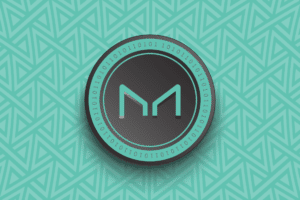
Yesterday Maker DAO announced the launch of a Maker Vault to invest USDC in liquid bonds worth up to 500 million DAI, or US dollars.
Maker Governance executed the first DAO balance sheet investment in high-quality bonds.
MIP65: Monetalis Clydesdale will activate a Maker Vault for the purpose of investing PSM’s USDC in liquid bond strategies with a debt ceiling of 500 million DAI. pic.twitter.com/LlpBUkYXxE
— Maker (@MakerDAO) October 6, 2022
An initial vote within the DAO has already approved the first 1 million DAI pilot transfer for this purpose, and further votes will be needed to complete the process until the 500 million DAI cap is reached.
80% of the funds will be invested in short-term US Treasury bonds, with the remaining 20% in IG Corporate Bonds.
• 80% in US Short-Term Treasuries (40% 0-1y US Treasury ishares ETF & 60% 1-3y US Treasury ishares ETF from BlackRock).
• 20% in IG Corporate Bond (split of US Treasury Index and Active global mandate for 0-5y investment grade corporate bonds from Baillie Gifford).
— Maker (@MakerDAO) October 6, 2022
Maker DAO’s plan to improve short-term liquidity
This is all part of the MIP65 Monetalis Clydesdale, which will activate an RWA vault to acquire USDC through PSM and invest them in high-quality liquid bonds held by a fund organized and maintained by Monetalis.
The official reasons for Maker DAO to make this choice are first and foremost that there is a large exposure in USDC on Maker’s balance sheet that yields no return. Bonds, on the other hand, at the very least provide one.
In addition, it is considered a priority to work with professional bond managers and initiate a diversification strategy.
It is worth remembering that DAI is an algorithmic stablecoin pegged to the value of the US dollar, thus subject to possible fluctuations due to the ability to maintain a more or less fixed market value around parity with USD.
Maker DAO is the DAO that manages DAI, so it is in fact responsible for its market value.
DAI is the fourth largest stablecoin in the world by market capitalization, with more than 6.3 billion tokens in circulation.
In the past, its value has ranged from $0.90 to $1.22, but from 2021 onward the range has narrowed. Indeed, in recent times it has never again fallen below $0.99, and it has never again risen above $1.01, except in a very rare instance in November 2021.
Even during the implosion of the Terra ecosystem in May, due to the loss of the peg with the dollar by the UST algorithmic stablecoin, DAI held up very well, never deviating from the range of precisely $0.99 to $1.01. This is a ±1% fluctuation range.
In spite of this, Maker DAO detected a possible vulnerability due to the large amount of USDC backing DAI’s value, and decided to reduce risk by diversifying the allocation of funds to collateralize DAI.
With this in mind, the choice of bonds, and in particular short-term US Treasuries, is in line with that of other stablecoin managers, because this effectively increases the probability that the value of the stablecoin will remain pegged to that of the US dollar.
DAI, Maker’s algorithmic stablecoin
It is worth noting that although DAI is an algorithmic stablecoin in some ways similar to UST, it has never had similar problems.
DAI was itself derived from an earlier stablecoin, now called SAI, from which it inherited the name, and which it replaced completely as of late 2019. SAI, once called DAI, was at first collateralized only in ETH (Ethereum), which meant that the risk of possible depeg was far from negligible.
Despite this, the lowest value ever touched by SAI was $0.92, so although there have been some problems in the past, the peg with the dollar was never really lost.
The thing is that Maker’s management has always been prudent, and they have always managed to step in when there were problems so as to at least save the peg over the medium/long term.
To the extent that at one point they decided it was too risky to just collateralize the algorithmic stablecoin with ETH, and opened up to other collateral, including Bitcoin. When this new direction was initiated, a new stablecoin was created and named DAI, while the previous one was renamed to SAI, and eventually replaced it almost completely.
As of today, there are only a little more than 21 million SAI in circulation, so much so that this is no longer a true stablecoin but a speculative token that during 2021 went as far as briefly exceeding the $25 price for purely speculative reasons.
One of the choices that has probably contributed the most to the new DAI’s peg with the dollar is precisely the fact that it has diversified the collateral, particularly by adding USDC. USDC is a non-algorithmic stablecoin, but 100% collateralized by US dollars or equivalent, issued by Circle in partnership with Coinbase.
It is the second-largest stablecoin in the world by market capitalization, with more than 46 billion tokens in circulation.
USDC and bonds in the Maker DAO ecosystem
The addition of USDC to Maker’s vault in support of DAI dramatically reduced the risk of peg loss, so much so that when UST imploded the market value of the algorithmic stablecoin DAI fell less than the collateralized stablecoin USDT did.
Moreover, the fact that the manager of DAI is a DAO, and not a team of people who can act arbitrarily, made it impossible to manage this algorithmic stablecoin in an arbitrary way. Changes or corrections to the basic strategy, and concrete actions, must always be approved by a specific vote before they can be executed, and this prevents headshots, or hand-wringing, that could have violent and sudden impacts on the peg.
DAOs like Maker’s are Decentralized Autonomous Organizations that, precisely because they are truly decentralized, do not have some sort of leader or narrow management team that can make decisions independently and arbitrarily.
For all these reasons, DAI is a very particular algorithmic stablecoin, and different from others. In fact, not only has it been holding up very well now for many months when faced with all the sensational things that have happened in the crypto markets, but it has also achieved a market capitalization over time that is enormously greater than that of any other algorithmic stablecoin other than UST.
However, UST imploded at some point, perhaps in part because of poor or risky management, and primarily because of a high-risk collateralization strategy that was very different from the low-risk strategy chosen recently by Maker DAO.
Now to further reduce an already quite low risk, Maker DAO has even decided to partially collateralize DAI with a small percentage of funds invested in US Treasury bonds.
$500 million out of over $6 billion in capitalization is small, or just over 8%, but it gives a very good idea of Maker DAO’s approach and strategy to try to reduce DAI’s depeg risk as much as possible.
UST’s strategy, on the other hand, was instead much riskier, probably with the goal more focused on making gains rather than minimizing depeg risks.
In the end, DAI’s strategy is paying off, given the robustness this algorithmic stablecoin is proving over time, while UST’s strategy has been a total failure.
Risk is not a good characteristic of algorithmic stablecoins at all, so much so that it can take even relatively little risk to completely blow up their basic strategy.
The post Maker DAO invests $500 million in US treasuries and bonds appeared first on The Cryptonomist.





















